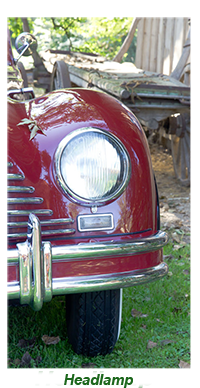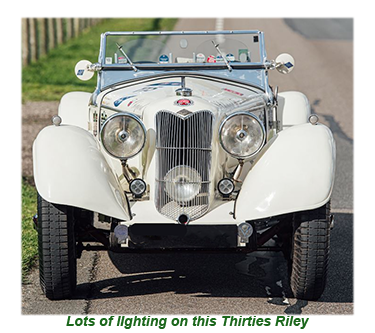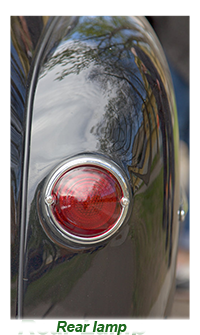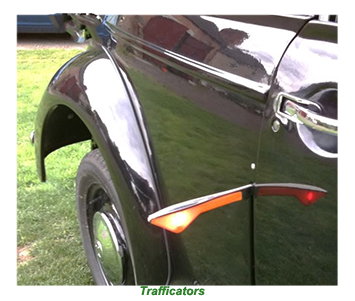 Since the early days of motoring, it has been common practice for car manufacturers to outsource their supply of lighting components from specialist suppliers in a classic case of "horses for courses."
Since the early days of motoring, it has been common practice for car manufacturers to outsource their supply of lighting components from specialist suppliers in a classic case of "horses for courses."

 The major UK and European car manufacturers worked hand in hand with the principal suppliers of vehicle lighting to develop systems that would suit their needs and design principles.
The major UK and European car manufacturers worked hand in hand with the principal suppliers of vehicle lighting to develop systems that would suit their needs and design principles.
The essential purpose of a vehicle lighting system is to allow the driver to see and their vehicle to be seen.
After the starter motor, the headlamps are the biggest draw on the power supply, while, unlike the starter, the headlamps will require to be in use for many hours at a time.
Though far smaller and primarily intended to allow others to see you, side lamps can also be used, particularly when the light is fading.
Vehicle headlamps are fed through a fuse, either as a pair or individually. That means that the first place to look should your lights fail will be the fuses.
 The most common problems encountered with lighting faults are earthing faults and poor connections, usually caused by contact with water.
The most common problems encountered with lighting faults are earthing faults and poor connections, usually caused by contact with water.
Connectors are generally self-cleaning, so merely removing and re-fitting the spade or plug may well improve things.

Where the earth lead runs to the bodywork, corrosion can occur, which will impede the electrical flow. Once again, a few minutes invested in cleaning up the rust will usually solve the problem.
 During the late Fifties and throughout the Sixties, the vast majority of domestic classics came fitted with standard headlamp units, usually of the sealed-beam or semi-sealed (ordinary) type, that included a single filament for dipped and another for high beam.
During the late Fifties and throughout the Sixties, the vast majority of domestic classics came fitted with standard headlamp units, usually of the sealed-beam or semi-sealed (ordinary) type, that included a single filament for dipped and another for high beam.
Many later models featured a four-headlamp design, with the inner pair acting as high beam only.
Stop, tail, and sidelights
Brake lights and side markers tend to suffer from the effects of water ingress even more than the headlamps, and vehicles from the fifties and early sixties commonly feature standard bullet shaped lamps. These units are still available off-the-shelf today, though they now come with plastic lenses instead of the cumbersome glass used in early light fittings.
Number plate lamps are required at the rear of the vehicle, and these should light up with the side markers.
Maintenance of brake and side lamps
Many designs will allow access to the bulbs by simple removal of the lens. Lamps that show screws are usually mounted from the outside of the bodywork.
Models which do not give a clue to their attachment will need to be unbolted from somewhere behind the panel. A generous squirt of WD40 or similar the day before attempting to undo aged fixings would be wise, as they are prone to breaking.

Direction indicators or trafficators
Flashing amber indicators have been the norm in the UK since the mid-fifties. Before then, semaphore type 'trafficators' were often fitted.
 The 'flashing is provided by a sealed canister which is usually found under the dashboard. The flash is not user-serviceable and costs very little to replace.
The 'flashing is provided by a sealed canister which is usually found under the dashboard. The flash is not user-serviceable and costs very little to replace.

The indicators are generally open using a stalk-type switch. At the same time, vehicles produced in Germany were wired so that a side lamp will remain lit when the indicator stalk is set to one side and the ignition is off.
While these manufacturers had the best of intentions, this safety feature has been the cause of more than a few flat batteries over the years.
The necessary parts to carry out this procedure can be found on the shelf of any good motor factor, are easily installed with the costs justified by the prevention of a flat battery and all the inconvenience caused.
 To counteract this problem and others of a similar nature, classic car restorers in the know have begun to fit a tell-tale lamp on the dashboard or, better still, a buzzer at the same time as the lights.
To counteract this problem and others of a similar nature, classic car restorers in the know have begun to fit a tell-tale lamp on the dashboard or, better still, a buzzer at the same time as the lights. Since the early days of motoring, it has been common practice for car manufacturers to outsource their supply of lighting components from specialist suppliers in a classic case of "horses for courses."
Since the early days of motoring, it has been common practice for car manufacturers to outsource their supply of lighting components from specialist suppliers in a classic case of "horses for courses." 
 The major UK and European car manufacturers worked hand in hand with the principal suppliers of vehicle lighting to develop systems that would suit their needs and design principles.
The major UK and European car manufacturers worked hand in hand with the principal suppliers of vehicle lighting to develop systems that would suit their needs and design principles. The most common problems encountered with lighting faults are earthing faults and poor connections, usually caused by contact with water.
The most common problems encountered with lighting faults are earthing faults and poor connections, usually caused by contact with water.  During the late Fifties and throughout the Sixties, the vast majority of domestic classics came fitted with standard headlamp units, usually of the sealed-beam or semi-sealed (ordinary) type, that included a single filament for dipped and another for high beam.
During the late Fifties and throughout the Sixties, the vast majority of domestic classics came fitted with standard headlamp units, usually of the sealed-beam or semi-sealed (ordinary) type, that included a single filament for dipped and another for high beam.  The 'flashing is provided by a sealed canister which is usually found under the dashboard. The flash is not user-serviceable and costs very little to replace.
The 'flashing is provided by a sealed canister which is usually found under the dashboard. The flash is not user-serviceable and costs very little to replace. 

